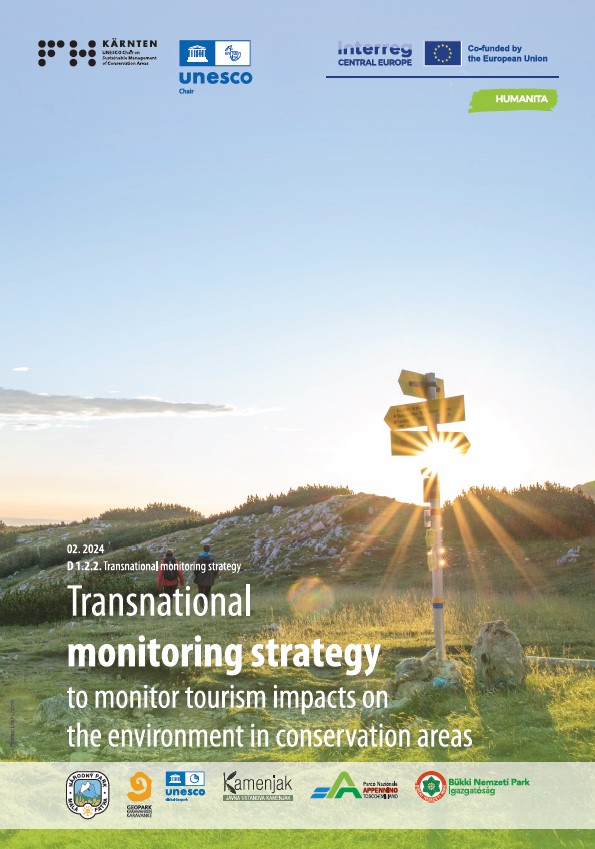HUMANITA project partner Carinthia University of Applied Sciences developed the Transnational monitoring strategy, one of the key deliverables and first output within the HUMANITA project. This transnational monitoring strategy proposes a framework for the development, testing, and evaluation of a monitoring system that supports visitor management activities of pilot sites within the INTERREG Central Europe project HUMANITA. The main goal of the INTERREG CE project HUMANITA is to produce a proposal for a more complex monitoring system for conservation areas (CAs) in regard to environmental impacts of outdoor tourism on natural assets. Together, project participants test different innovative monitoring methods and approaches. These results and analyses will enable to draw up policy recommendations and develop local action plans for pilot sites in five regions: Bükk National Park in Hungary, Mala Fatra National Park in Slovakia, Tuscan-Emilian Apennine National Park in Italy, Significant landscape Lower Kamenjak and the Medulin Archipelago in Croatia and Karawanken-Karavanke UNESCO Global Geopark on the border between Austria and Slovenia. For the development of the transnational monitoring strategy, HUMANITA project partners employ a comprehensive framework and workflow for biodiversity monitoring, that was developed by Dalton et al. (in press) as a new standard for biodiversity monitoring. This framework is supported by IUCN WCPA and is designed to provide CA managers and their partners with a unified approach, enabling the production of valid and comparable data. The biodiversity monitoring framework will be adapted to target the needs for planning and conceptualizing a monitoring plan that focuses on monitoring human pressures on the environment. The four-phase monitoring framework is structured in the preparatory, the conceptual, the implementation, and the re-evaluation phases. Within the preparatory phase, each of the five CA partners produced reports identifying the impacts of tourism within their respective regions. These reports offer crucial baseline insights into areas experiencing tourism pressures and vulnerable zones affected by tourist activities. Pilot sites serve as focal points of the project’s investigation and are presented in detail, outlining their characteristics in regard to their natural values and touristic activities, monitoring requirements and information gaps. The transnational monitoring strategy emerges as the final output of the conceptual phase of the monitoring framework. It is not solely a strategic document but it can rather be seen as a planning document for HUMANITA project partners. It serves as a guide for addressing basic questions about the intended monitoring programme. The strategy, developed collaboratively by project partners, outlines a unified approach to monitoring that is modular and applicable to different situations, reflecting the current state of biodiversity and the impacts of tourism at each site. By establishing a priority list of monitoring targets, the transnational monitoring strategy sets the stage for the subsequent implementation and re-evaluation phases, driving the project activities towards effective, adaptable, and sustainable visitor management practices in CAs. In regards to potential resource limitations of CAs, the results and insights of the HUMANITA monitoring programme will allow partners to exchange their experiences and to identify a minimum number of representative indicators that can be recommended for inclusion into a general monitoring catalogue. This body of experience will provide a basis for a continuous monitoring programme for CAs focusing on impacts of tourism within CAs of Central Europe.
Manage Cookie Consent
To provide the best experiences, we use technologies like cookies to store and/or access device information. Consenting to these technologies will allow us to process data such as browsing behavior or unique IDs on this site. Not consenting or withdrawing consent, may adversely affect certain features and functions.
Functional Always active
The technical storage or access is strictly necessary for the legitimate purpose of enabling the use of a specific service explicitly requested by the subscriber or user, or for the sole purpose of carrying out the transmission of a communication over an electronic communications network.
Preferences
The technical storage or access is necessary for the legitimate purpose of storing preferences that are not requested by the subscriber or user.
Statistics
The technical storage or access that is used exclusively for statistical purposes.
The technical storage or access that is used exclusively for anonymous statistical purposes. Without a subpoena, voluntary compliance on the part of your Internet Service Provider, or additional records from a third party, information stored or retrieved for this purpose alone cannot usually be used to identify you.
Marketing
The technical storage or access is required to create user profiles to send advertising, or to track the user on a website or across several websites for similar marketing purposes.
